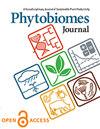Irrigation water source matters: Saline groundwater irrigation lowers date palm root-associated fungal richness and alters their community structural patterns
IF 3.3
3区 生物学
Q2 MICROBIOLOGY
引用次数: 0
Abstract
Saline groundwater irrigation is commonly used in arid regions of the Middle East and North Africa for date palm (Phoenix dactylifera) cultivation, yet little is known about its impact on root-associated fungal (RAF) communities. We investigated the impact of irrigation water sources (freshwater vs. saline groundwater) on date palm RAF diversity, communities, and their assembly processes. RAF richness was lower in roots under saline groundwater irrigation and was significantly related to soil and water electrical conductivity (EC), and only 25.3% of the total operational taxonomic units (OTUs) were strictly found in roots under saline groundwater irrigation. Overall, the RAF communities were distinct among irrigation water sources, wherein water pH and EC were the major structuring factors. The relative importance of drift assembly was higher for RAF distribution under saline groundwater irrigation. Saprotrophic and pathotrophic communities were also distinct between irrigation water sources and shaped by irrigation water pH. In addition, we found higher abundance of saprotrophic OTUs Acrocalymma vagum, Coprinopsis sp., and Myrothecium sp. in roots under saline groundwater irrigation. Summarily, we show that saline groundwater irrigation lowers RAF richness, alters overall and guild level RAF communities (saprotroph and pathotroph) which assemble mainly through drift process, wherein overall communities are shaped by irrigation water pH and EC, while saprotrophic and pathotrophic communities are structured by water pH. The high abundance of specific saprotrophs under saline groundwater irrigation indicates their potential role in nutrient cycling and plant growth promotion in arid agroecosystems.灌溉水源很重要:盐水灌溉降低了与椰枣根相关的真菌丰富度,并改变了它们的群落结构模式
盐水灌溉通常用于中东和北非干旱地区的椰枣种植,但对其对根相关真菌(RAF)群落的影响知之甚少。我们调查了灌溉水源(淡水与盐水)对椰枣RAF多样性、群落及其组装过程的影响。在盐水灌溉条件下,根系的RAF丰富度较低,与土壤和水的电导率(EC)显著相关,而在盐水灌溉下,根系中只有25.3%的操作分类单元(OTU)。总体而言,灌溉水源中的RAF群落是不同的,其中水的pH值和EC是主要的结构因素。在盐水灌溉条件下,漂移组件对RAF分布的相对重要性更高。灌溉水源之间的腐营养和病理营养群落也不同,并受灌溉水pH的影响。此外,我们在盐水灌溉下的根系中发现了更高丰度的腐营养OTU Acroclymma vagum、Coprinopsis sp.和Myrothecium sp。总之,我们表明,盐水灌溉降低了RAF的丰富度,改变了主要通过漂移过程聚集的整体和公会水平的RAF群落(腐养生物和病理营养生物),其中整体群落由灌溉水的pH和EC形成,而腐养和病理营养群落由水的pH构成。盐水灌溉下特定腐生物的高丰度表明它们在干旱农业生态系统中的营养循环和植物生长促进中具有潜在作用。
本文章由计算机程序翻译,如有差异,请以英文原文为准。
求助全文
约1分钟内获得全文
求助全文

 求助内容:
求助内容: 应助结果提醒方式:
应助结果提醒方式:


